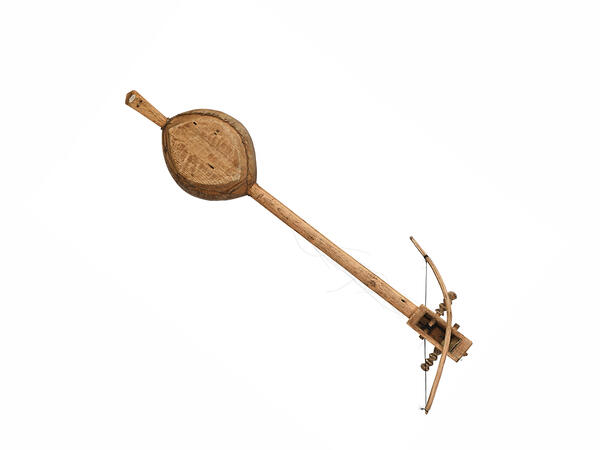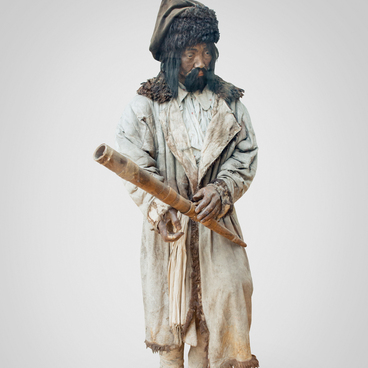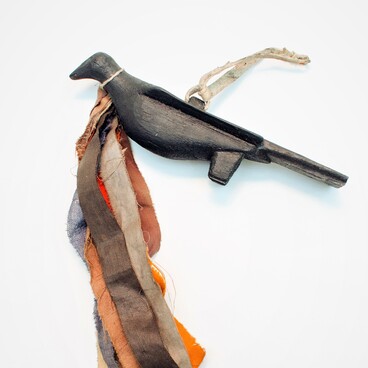Igil belongs to the most ancient and widespread Tuvan musical instruments. It was a two-stringed bowed instrument with a long melodious sound. The music of the igil was believed to have healing, calming, and cleansing powers.
Elderly Tuvan shamans believed that the igil was a sacred instrument with which one can establish communication with the spirits. Tuvans associated it with their favorite domestic animal, best friend, and companion — the horse. That was why igil strings were made of horsetail hair, and the end of the string arm was often decorated with a carved figurine of a horse.
The igil’s body was made of a whole piece of wood — it was hollowed out in the shape of an oval dipper pointed downwards. Usually pine, larch, or cedar were chosen. The deck was covered with leather of goats and sheep.
Elderly Tuvan shamans believed that the igil was a sacred instrument with which one can establish communication with the spirits. Tuvans associated it with their favorite domestic animal, best friend, and companion — the horse. That was why igil strings were made of horsetail hair, and the end of the string arm was often decorated with a carved figurine of a horse.
The igil’s body was made of a whole piece of wood — it was hollowed out in the shape of an oval dipper pointed downwards. Usually pine, larch, or cedar were chosen. The deck was covered with leather of goats and sheep.
The fiddlestick (cha, chanzh) was made in the form of a bow from the branches of a willow plant and its bowstring from horsehair, which gave the instrument a soft timbre. The bowstring was rubbed with larch or cedar resin.
Each craftsman had his own secrets for choosing the right wood and then processing it. Usually, these details were kept in secret and passed from father to son.
The skill of the craftsmen who made the musical instruments was even praised in heroic tales. They said that special rituals accompany this complex process, and the master selects different species of trees, which mystically complement each other and make the sound of the igil richer and deeper.
The names of this instrument vary from one nation to another. The Altai people have a variant of the name ‘ikili’, the Khakass people have ‘yykh’. Tuvans had a paired instrument to the igil — a relative of the morin khuur. Both are ensemble instruments and complement each other when played.
The instruments are even similar in shape, string material, and the main decoration — a carved figure on the end of the neck. The morin khuur has Mongolian roots, but both instruments are thought to imitate the sound of a horse neighing, the wind howling in the steppe, and to convey the slowness, continuity of nomadic life.
However, the tone of the igil and the technique of playing it differs from other bowed or stringed instruments. Each of its strings consists of many thin veins — thanks to this you can achieve different shades of sound. In addition, on this musical instrument, you can combine different techniques if you want: to clasp the strings, to pinch, or, for example, to play from the side.
Closely related to the igil are the traditions of throat singing and improvisation, where the performer alternates between recitative and chant. Therefore, Tuvans believe that the very sound of the instrument helps musicians master timbres and intonations inaccessible to the voice.
Each craftsman had his own secrets for choosing the right wood and then processing it. Usually, these details were kept in secret and passed from father to son.
The skill of the craftsmen who made the musical instruments was even praised in heroic tales. They said that special rituals accompany this complex process, and the master selects different species of trees, which mystically complement each other and make the sound of the igil richer and deeper.
The names of this instrument vary from one nation to another. The Altai people have a variant of the name ‘ikili’, the Khakass people have ‘yykh’. Tuvans had a paired instrument to the igil — a relative of the morin khuur. Both are ensemble instruments and complement each other when played.
The instruments are even similar in shape, string material, and the main decoration — a carved figure on the end of the neck. The morin khuur has Mongolian roots, but both instruments are thought to imitate the sound of a horse neighing, the wind howling in the steppe, and to convey the slowness, continuity of nomadic life.
However, the tone of the igil and the technique of playing it differs from other bowed or stringed instruments. Each of its strings consists of many thin veins — thanks to this you can achieve different shades of sound. In addition, on this musical instrument, you can combine different techniques if you want: to clasp the strings, to pinch, or, for example, to play from the side.
Closely related to the igil are the traditions of throat singing and improvisation, where the performer alternates between recitative and chant. Therefore, Tuvans believe that the very sound of the instrument helps musicians master timbres and intonations inaccessible to the voice.



